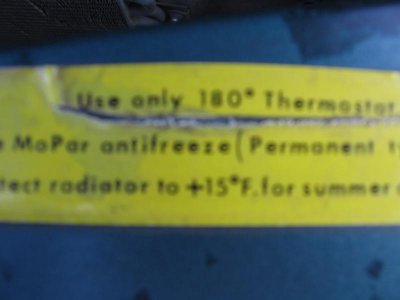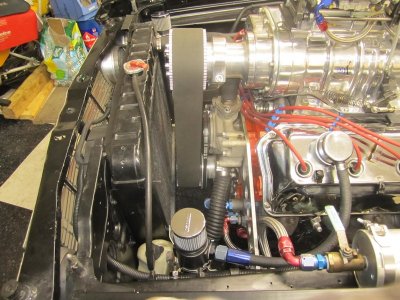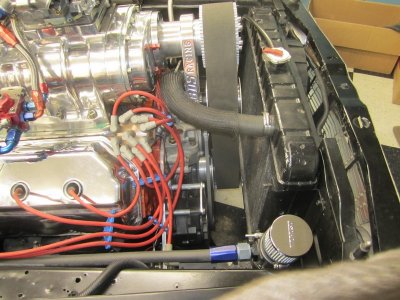696pack
Well-Known Member
PLEASE MAKE THIS A STICKY.
I have posted most of this previously and thought it was a sticky but can’t find it so here goes again.
We see so many posts with people having cooling problems that have added aftermarket radiators and electric fans thinking they are improving things.
Don’t try to reinvent the wheel.
The standard H.D. factory cooling system should be fine for cars with 600 h.p. This system consists of 26” radiator with fan shroud and clutch fan. The clutch fan disengages when not needed saving the power robbing of the fan and basically free wheels.
Make sure your fan is placed properly about 1” inside the fan shroud. Some of the original cooling systems have some rubber or foam sealing around any air gaps around the shroud and radiator, if yours doesn’t it is a good idea to do so. Simple closed cell foam tape will work. This system was created by factory engineers and WORKS. Why? Because the shroud encompasses the entire back side of the radiator cooling area and creates a vortex with the fan in its proper place sucking the hot air off of the radiator from all surfaces of the radiator. Electric cooling fans are their own obstruction in this path of air. Don’t be confused by the fact that newer cars have electric cooling fans and work. Again that is a factory engineered system for a specific vehicle.
Another common mistake is using an aftermarket “high performance” water pump. The factory standard pump is usually fine and at the most you may want to use the factory pump that was designed for an A/C equipped car. If memory serves me correctly I believe that pump actually moves the coolant through the system SLOWER. Why? Because it has more time for the radiator to pull the heat out of the hot water. Most of the “high performance” water pumps move the water through the radiator too fast and does not give it enough time to remove the heat.
Thermostats are another problem. Some people that don’t understand their purpose will use a 160 degree unit thinking it will make the car run cooler. The 160 degree opens at that temp. but that doesn’t mean it is going to keep the temp. there. The factory suggested T-stat for our old cars is a 195. That is because your engine is designed to operate more effciently at that temp. On newer cars it is a 205 because of pollution control and a hotter engine burns more hydrocarbon than a cooler engine.
Timing is another issue for cooling. Especially with todays poor fuel. If you are running too much advance and your engine is predetonating (pinging that is not always autible) it will create addtional heat in the cumbustion chamber and may also cause you to burn valves or a hole in the pistons. This addition heat makes your cooling system work harder and may not suffeciently cool the engine. It can also cause starter bind (hard or slow staring wnen the engine is hot. This is caused by the starter expanding from the heat and being too tight. If your car was factory equipped with a heat sheild make sure you use one. If you have added headers and one or more of the tubes are close to the starter wrap those tubes with some type of fire retardant insulation material. DO NOT wrap the starter as it will eventually absorb the heat and then hold it there.
I have posted most of this previously and thought it was a sticky but can’t find it so here goes again.
We see so many posts with people having cooling problems that have added aftermarket radiators and electric fans thinking they are improving things.
Don’t try to reinvent the wheel.
The standard H.D. factory cooling system should be fine for cars with 600 h.p. This system consists of 26” radiator with fan shroud and clutch fan. The clutch fan disengages when not needed saving the power robbing of the fan and basically free wheels.
Make sure your fan is placed properly about 1” inside the fan shroud. Some of the original cooling systems have some rubber or foam sealing around any air gaps around the shroud and radiator, if yours doesn’t it is a good idea to do so. Simple closed cell foam tape will work. This system was created by factory engineers and WORKS. Why? Because the shroud encompasses the entire back side of the radiator cooling area and creates a vortex with the fan in its proper place sucking the hot air off of the radiator from all surfaces of the radiator. Electric cooling fans are their own obstruction in this path of air. Don’t be confused by the fact that newer cars have electric cooling fans and work. Again that is a factory engineered system for a specific vehicle.
Another common mistake is using an aftermarket “high performance” water pump. The factory standard pump is usually fine and at the most you may want to use the factory pump that was designed for an A/C equipped car. If memory serves me correctly I believe that pump actually moves the coolant through the system SLOWER. Why? Because it has more time for the radiator to pull the heat out of the hot water. Most of the “high performance” water pumps move the water through the radiator too fast and does not give it enough time to remove the heat.
Thermostats are another problem. Some people that don’t understand their purpose will use a 160 degree unit thinking it will make the car run cooler. The 160 degree opens at that temp. but that doesn’t mean it is going to keep the temp. there. The factory suggested T-stat for our old cars is a 195. That is because your engine is designed to operate more effciently at that temp. On newer cars it is a 205 because of pollution control and a hotter engine burns more hydrocarbon than a cooler engine.
Timing is another issue for cooling. Especially with todays poor fuel. If you are running too much advance and your engine is predetonating (pinging that is not always autible) it will create addtional heat in the cumbustion chamber and may also cause you to burn valves or a hole in the pistons. This addition heat makes your cooling system work harder and may not suffeciently cool the engine. It can also cause starter bind (hard or slow staring wnen the engine is hot. This is caused by the starter expanding from the heat and being too tight. If your car was factory equipped with a heat sheild make sure you use one. If you have added headers and one or more of the tubes are close to the starter wrap those tubes with some type of fire retardant insulation material. DO NOT wrap the starter as it will eventually absorb the heat and then hold it there.


















